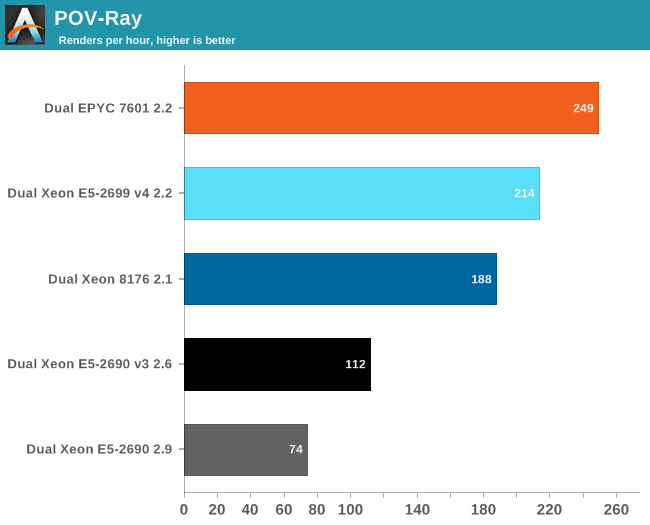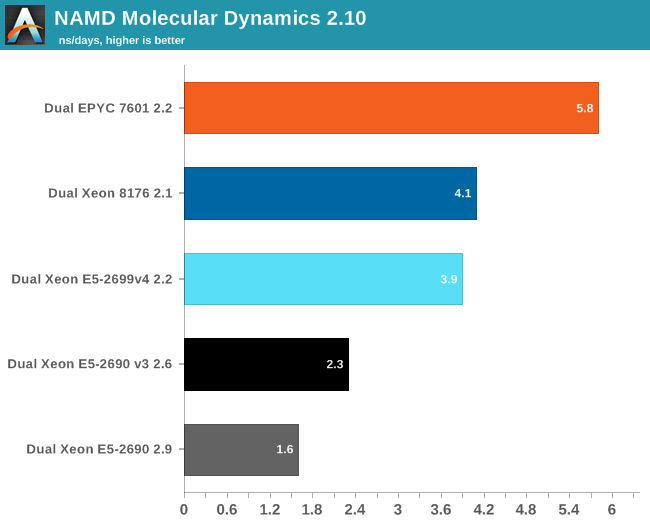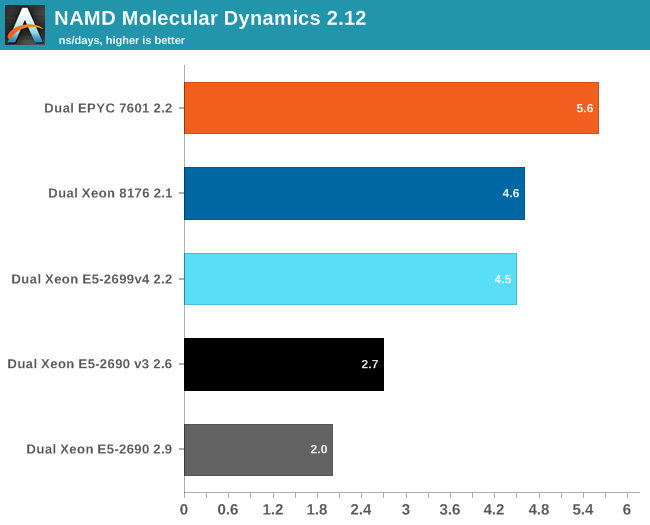Sizing Up Servers: Intel's Skylake-SP Xeon versus AMD's EPYC 7000 - The Server CPU Battle of the Decade?
by Johan De Gelas & Ian Cutress on July 11, 2017 12:15 PM EST- Posted in
- CPUs
- AMD
- Intel
- Xeon
- Enterprise
- Skylake
- Zen
- Naples
- Skylake-SP
- EPYC
Floating Point
Normally our HPC benchmarking is centered around OpenFoam, a CFD software we have used for a number of articles over the years. However, since we moved to Ubuntu 16.04, we could not get it to work anymore. So we decided to change our floating point intensive benchmark for now. For our latest article, we're testing with C-ray, POV-Ray, and NAMD.
The idea is to measure:
- A FP benchmark that is running out of the L1 (C-ray)
- A FP benchmark that is running out of the L2 (POV-Ray)
- And one that is using the memory subsytem quite often (NAMD)
Floating Point: C-ray
C-ray is an extremely simple ray-tracer which is not representative of any real world raytracing application. In fact, it is essentially a floating point benchmark that runs out of the L1-cache. Luckily it is not as synthetic and meaningless as Whetstone, as you can actually use the software to do simple raytracing.
We use the standard benchmarking resolution (3840x2160) and the "sphfract" file to measure performance. The binary was precompiled.

Wow. What just happened? It looks like a landslide victory for the raw power of the four FP pipes of Zen: the EPYC chip is no less than 50% faster than the competition. Of course, it is easy to feed FP units if everything resides in the L1. Next stop, POV-Ray.
Floating Point: POV-Ray 3.7

POV-Ray is known to run mostly out of the L2-cache, so the massive DRAM bandwidth of the EPYC CPU does not play a role here. Nevertheless, the EPYC CPU performance is pretty stunning: about 16% faster than Intel's Xeon 8176. But what if AVX and DRAM access come in to play? Let us check out NAMD.
Floating Point: NAMD
Developed by the Theoretical and Computational Biophysics Group at the University of Illinois Urbana-Champaign, NAMD is a set of parallel molecular dynamics codes for extreme parallelization on thousands of cores. NAMD is also part of SPEC CPU2006 FP. In contrast with previous FP benchmarks, the NAMD binary is compiled with Intel ICC and optimized for AVX.
First, we used the "NAMD_2.10_Linux-x86_64-multicore" binary. We used the most popular benchmark load, apoa1 (Apolipoprotein A1). The results are expressed in simulated nanoseconds per wall-clock day. We measure at 500 steps.

Again, the EPYC 7601 simply crushes the competition with 41% better performance than Intel's 28-core. Heavily vectorized code (like Linpack) might run much faster on Intel, but other FP code seems to run faster on AMD's newest FPU.
For our first shot with this benchmark, we used version 2.10 to be able to compare to our older data set. Version 2.12 seems to make better use of "Intel's compiler vectorization and auto-dispatch has improved performance for Intel processors supporting AVX instructions". So let's try again:

The older Xeons see a perforance boost of about 25%. The improvement on the new Xeons is a lot lower: about 13-15%. Remarkable is that the new binary is slower on the EPYC 7601: about 4%. That simply begs for more investigation: but the deadline was too close. Nevertheless, three different FP tests all point in the same direction: the Zen FP unit might not have the highest "peak FLOPs" in theory, there is lots of FP code out there that runs best on EPYC.










219 Comments
View All Comments
Shankar1962 - Wednesday, July 12, 2017 - link
AMD is fooling everyone one by showing more cores, pci lanes, security etcCan someone explain me why GOOGLE ATT AWS ALIBABA etc upgraded to sky lake when AMD IS SUPERIOR FOR HALF THE PRICE?
Shankar1962 - Wednesday, July 12, 2017 - link
Sorry its BaiduPretty sure Alibaba will upgrade
https://www.google.com/amp/s/seekingalpha.com/amp/...
PixyMisa - Thursday, July 13, 2017 - link
Lots of reasons.1. Epyc is brand new. You can bet that every major server customer has it in testing, but it could easily be a year before they're ready to deploy.
2. Functions like ESXi hot migration may not be supported on Epyc yet, and certainly not between Epyc and Intel.
3. Those companies don't pay the same prices we do. Amazon have customised CPUs for AWS - not a different die, but a particular spec that isn't on Intel's product list.
There's no trick here. This is what AMD did before, back in 2006.
blublub - Tuesday, July 11, 2017 - link
I kinda miss Infinity Fabric on my Haswell CPU and it seems to only have on die - so why is that missing on Haswell wehen Ryzen is an exact copy?blublub - Tuesday, July 11, 2017 - link
argh that post did get lost.zappor - Tuesday, July 11, 2017 - link
4.4.0 kernel?! That's not good for single-die Zen and must be even worse for Epyc!AMD's Ryzen Will Really Like A Newer Linux Kernel:
https://www.phoronix.com/scan.php?page=news_item&a...
Kernel 4.10 gives Linux support for AMD Ryzen multithreading:
http://www.pcworld.com/article/3176323/linux/kerne...
JohanAnandtech - Friday, July 21, 2017 - link
We will update to a more updated kernel once the hardware update for 16.04 LTS is available. Should be August according to Ubuntukwalker - Tuesday, July 11, 2017 - link
You mention an OpenFOAM benchmark when talking about the new mesh topology but it wasn't included in the article. Any way you could post that? We are trying to evaluate EPYC vs Skylake for CFD applications.JohanAnandtech - Friday, July 21, 2017 - link
Any suggestion on a good OpenFoam benchmark that is available? Our realworld example is not compatible with the latest OpenFoam versions. Just send me an e-mail, if you can assist.Lolimaster - Tuesday, July 11, 2017 - link
AMD's lego design where basically every CCX can be used in whatever config they want be either consumer/HEDT or server is superior in the multicore era.Cheaper to produce, cheaper to sell, huge profits.